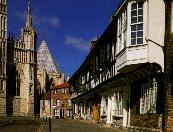Far more unpleasant was the criminal whose spectre stalks the corridors of St William's College in College Street behind York Minster. During the reign of Charles I, the college housed several wealthy clerics as well as more humble lodgers. Among the poorer residents were two brothers. The elder planned to rob one of the clergymen and persuaded his younger brother to help him.
 One dark night the two brothers lay in wait in one of the narrow streets of the city. When a likely victim came within reach they pounced. In the scuffle which followed, the elder brother whipped out a dagger and stabbed the victim dead. The younger brother was horrified by the turn of events and fled back to their lodgings with the cleric's purse. Locking himself in a cupboard, the man seemed on the point of breakdown. Desperate that his brother would tell all, the elder brother decided to beat him to it. He contacted the authorities and betrayed his brother in return for a pardon.
One dark night the two brothers lay in wait in one of the narrow streets of the city. When a likely victim came within reach they pounced. In the scuffle which followed, the elder brother whipped out a dagger and stabbed the victim dead. The younger brother was horrified by the turn of events and fled back to their lodgings with the cleric's purse. Locking himself in a cupboard, the man seemed on the point of breakdown. Desperate that his brother would tell all, the elder brother decided to beat him to it. He contacted the authorities and betrayed his brother in return for a pardon.
The younger and relatively blameless brother was duly tried and hanged. The elder brotherwvalked free from the law but not free from his conscience. He walked with the nagging and persistent demon of guilt on his shoulder. Sleep
constantly eluded him so he spent his nights plodding the corridors of St William's College. Night after night, week after week, the footsteps pounded the wooden floors as the man paced out his guilt. Then one night no footsteps
were heard. The following morning the man was found dead in his room. A few weeks later the guilty footsteps were heard again and may still be heard to this day. Remorse has outlived death.
Equally disturbing is the presence which lurks in Judge's Court, a snickleway off Coney Street. The haunting; goes back to the last century when a large man with dragging footsteps and a strange tinkling sound was first reported. He has continued to be one of the most active ghosts of York. He even appeared when a tourist guide, who was showing a group of visitors around the city, paused in the Judg~'s Court to describe a point of interest. Though nobody knows who this ghost is, part of the mystery was possibly solved when renovations were carried out to Judge's Court. Hidden in one building was a disused well. At the bottom of the well lay a body. The bones were those of a large man wearing riding boots, one of which had a broken spur. This was taken to explain the tinkling which accompanies the ghostly resident. Who the man was and how he came to lie in the well, nobody can explain.
Just as mysterious are the two ghosts which haunt the Black Swan on Peasholme Green. This is the oldest pub in York, dating back to the l6th century but its ghosts date from more recent times. The first and most often seen is a young lady in a long white dress who stands in the bar gazing intently at the fireplace. She has long, flaxen hair and appears to glow slightly. Less often encountered is a little Victorian workman wearing a bowler hat. He fidgets and tuts as if waiting for someone or something, he then fades into nothingness.
In Coppergate is a row of shops occupying the site of the former Craven's Sweet factory. The shops seem to have inherited more than the site from the old building. The factory was persistently troubled by a poltergeist which was felt most strongly in a downstairs workroom. Today, it has returned with redoubled energy to plague the row of shops which at present include the Body Shop, Olympus Sports and Fagin's Bookshop.
The poltergeist has a fascination with electrics and clothes, both of which are interfered with regularly. Assuming the poltergeist to be genuine, its most dramatic act was to break the glass fire alarm point in the depths of night and
bring the York fire brigade to the site at high speed. So enjoyable did the poltergeist find this that it apparently went on to break the replaced alarm twice more before dawn. It must have tired of this prank, however, for the fire brigade have not been called to the premises recently.
For the next ghost of York we must return yet again to the King's Manor, already described as the haunt of a monk, a Tudor lady, and wounded Roundheads. This ghost is in many ways typical of the ghosts of York.
Nobody is entirely certain who the ghost is, though some claim to have a good idea and his appearance is both sudden and dramatic. The spirit materialises in one spot only, on the staircase in the North Wing which leads
to the Huntingdon Room. The eerie, silent grey phantom is often seen. Almost invariably the portrait of a Stuart dignitary is taken off the wall and found lying on the floor after the phantom appears. This is generally said
to be the ghost of Henry Hastings who built the staircase. What relationship he has to the portrait is totally unknown.
The King's Manor, like York as a whole, has a crowd of phantoms lurking in the shadows - some terrifying, some charming and some enigmatic - but all ready at any moment to cross the threshold into our world.